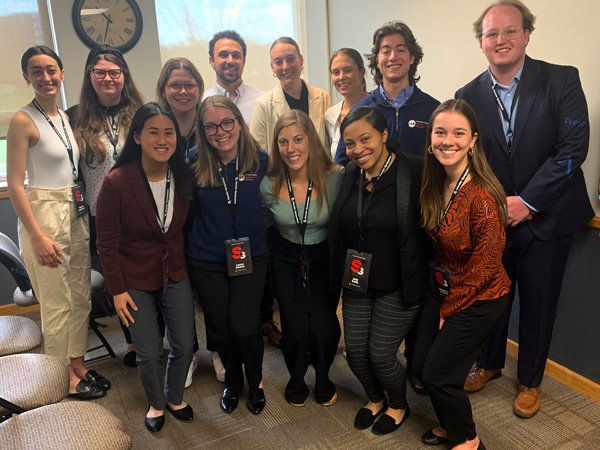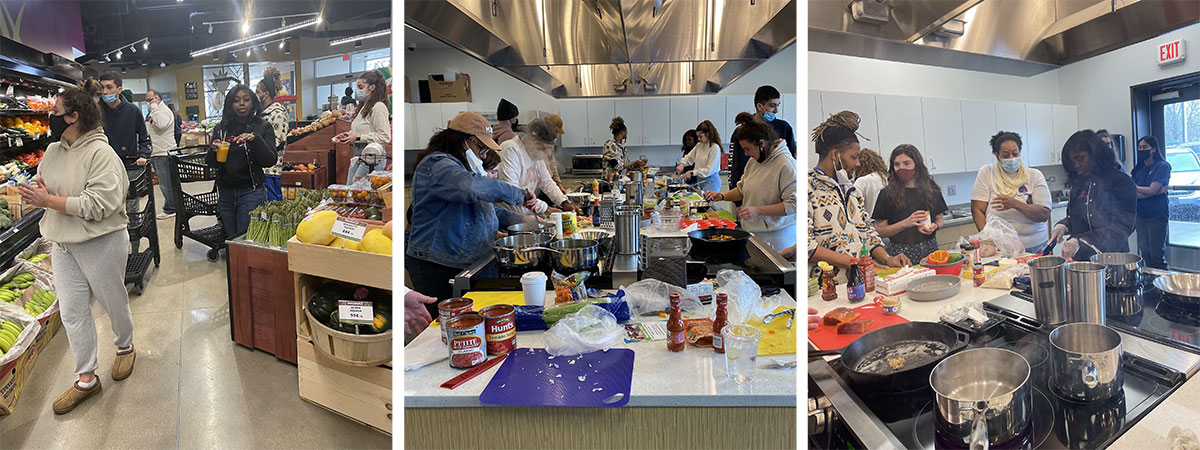A tasty learning laboratory
When the Dayton Civic Scholars hosted a “cook off” at Gem City Market this spring, teams of community members and University of Dayton students raced down the aisles of the West Dayton cooperative grocery store in search of $25 worth of ingredients for whipping up an affordable, healthy meal.
In 45 minutes, they quickly assembled and cooked salmon dishes, whole wheat pasta drenched in Italian Bolognese sauce, a low-carb stir fry and stuffed bell peppers, among other culinary concoctions, in the market’s teaching kitchen that’s used for classes and nutrition programs.
“I felt like we were on a cooking show,” said sociology major Rose Arkus at the Stander Symposium, where she joined a dozen other students in presenting their capstone project.
For nearly a year, the Dayton Civic Scholars, comprised of students from all majors interested in developing their community leadership skills, worked with Gem City Market on marketing, transportation and programming initiatives. They created greater awareness and engagement among UD students through events like a “UD Day at the Market,” which encouraged their classmates to break “the UD bubble” and learn about food apartheid and ways to alleviate it in Dayton. According to the Food Research and Action Center, Dayton is in the bottom quartile of cities in the nation in food hardship for families with children.
Gem City Market, located across the Salem Avenue bridge from downtown, includes a grocery with plentiful fresh fruits and vegetables; a deli; community room; health clinic; and coffeehouse. Opening last May, the co-op is owned by its 25 employees and more than 5,000 members.
“The Dayton Civic Scholars brought passion and they brought belief in what was possible,” said Amaha Sellassie, president of the board of Gem City Market and a sociologist who directs the Center for Applied Social Issues at Sinclair Community College. “They helped develop deeper relationships between Gem City Market and the mission of UD.”
Rachel Carr ’20, program coordinator for the Dayton Civic Scholars, said the students created a bridge: “As Dayton Civic Scholars, they heard about Gem City Market's need for shoppers as they opened mid-pandemic. As students, they understood the misperceptions around the market among other students and their potential to be shoppers at the market. They used their partnership with Gem City Market to be able to show students that they are welcomed off campus and what assets we have in the community.”
“They used their partnership with Gem City Market to be able to show students that they are welcomed off campus and what assets we have in the community.”
At a Gem City Market Info Night in the Kennedy Union ballroom in November and February, 200 students visited stations that displayed information about Gem City Market and food apartheids. They played a version of “The Price is Right” where they guessed prices of the market’s food and won prizes. Before and after the event, they took surveys about their knowledge of the market, co-ops and food insecurity. The students’ concern about food insecurity in Dayton doubled (from 44% to 88%), a huge swing in awareness.

Throughout the capstone project, the Dayton Civic Scholars experimented with ways to make it convenient for students to shop at Gem City Market, finally commissioning a UD shuttle this semester.
“Part of realizing a bubble exists is stepping outside of it,” Sellassie observed. “We have to unlearn to learn about race and class that has been formed about how we interact with others. We see the Gem City Market as a learning laboratory and a catalyst for community.”
“We see the Gem City Market as a learning laboratory and a catalyst for community.”
Charlie Baker, an accounting major, participated in a phone bank that reached out to every Gem City Market member before the store opened to help drum up early sales. “I really felt like we were building community,” he said during the Stander Symposium presentation. “I hope we laid out a template for what it’s like (for the University) to engage with the market going forward.”
Sellassie said he wants to involve more student interns from UD’s Fitz Center for Leadership in Community, Human Rights Center and Hanley Sustainability Institute in helping to “co-create” initiatives at the Gem City Market.
“We have to intentionally co-create the market together,” he said. “That’s where the power of hope comes from. Hope comes from knowing we can create a different future.”
